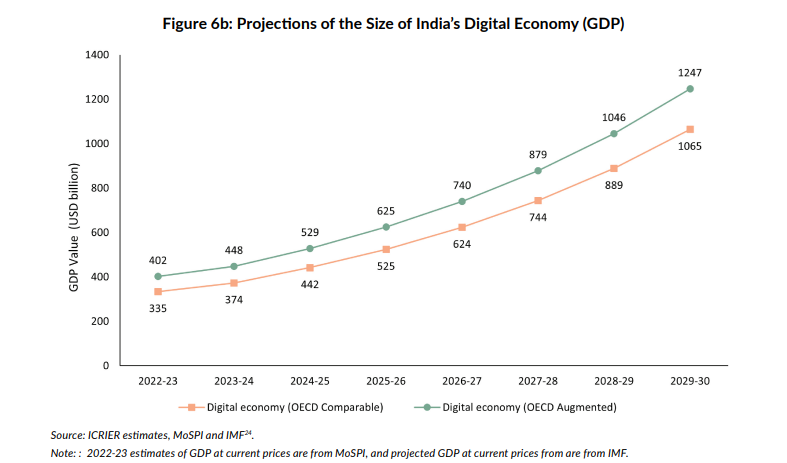In 2022-23, India’s digital economy contributed INR 31.64 lakh crore to GDP, accounting for 11.74% of the national income. The sector employed 14.67 million workers, representing 2.55% of India’s workforce.
India’s digital economy is emerging as a critical driver of the nation’s economic growth, with an estimated contribution of 11.74% to the national income in 2022-23. As the country sets its sights on ambitious growth targets, the digital economy is poised to contribute nearly one-fifth of the GDP by 2030. A recently released report by the Ministry of Electronics and Information Technology (MeitY), titled Estimation and Measurement of India’s Digital Economy, provides a comprehensive analysis of the current state and future potential of India’s digital sector, offering crucial insights for policymakers and industry stakeholders.
Defining the Digital Economy: Challenges and Innovations
The digital economy’s cross-sectoral nature makes its precise measurement challenging. The traditional national accounting systems do not readily accommodate the new dimensions introduced by digital technologies. Recognizing this, MeitY adopted the Organisation for Economic Cooperation and Development (OECD) framework to estimate the size of the digital economy, supplemented by the input-output approach of the Asian Development Bank (ADB). This dual-methodology approach positions India among a select group of nations—and the first among developing countries—to undertake such an in-depth assessment.
India’s digital economy is not confined to the Information and Communication Technology (ICT) sector. It encompasses contributions from traditional industries such as banking, financial services, insurance (BFSI), trade, and education, highlighting the pervasive impact of digital transformation.
Key Insights from the Report
1. Digital Economy’s Current Contribution
In 2022-23, India’s digital economy contributed INR 31.64 lakh crore (~USD 402 billion) to GDP, accounting for 11.74% of the national income. The sector employed 14.67 million workers, representing 2.55% of India’s workforce.
2. Sectoral Contributions
- Digital-Enabling Industries: This segment, including ICT services and electronic manufacturing, contributed 7.83% to the Gross Value Added (GVA).
- New Digital Industries: Comprising Big Tech players, digital platforms, and firms reliant on digital intermediaries, these accounted for nearly 2% of GVA.
- Digitalization of Traditional Industries: BFSI, trade, and education sectors contributed an additional 2% to GVA, underscoring the expanding reach of digital technologies.
3. Projected Growth
The digital economy is expected to grow at nearly twice the rate of the overall economy, with its contribution projected to reach 20% of GDP by 2030. This growth will be driven by digital intermediaries, higher digital diffusion, and the continued digitalization of traditional sectors.

Unlocking the Potential of Digital Growth
Addressing Gaps in Data and Inclusion
While the report provides valuable estimates, its findings are conservative due to limitations in data availability. Key gaps include the exclusion of smaller digital platforms, the informal sector’s digitalization, and other traditional sectors like health and logistics. Closing these data gaps will enhance the accuracy of future assessments and ensure that the benefits of digital growth are equitably distributed.
Policy Implications
The insights from the report are vital for shaping effective policy frameworks. By identifying priority areas, the government can:
- Foster innovation through targeted investments in emerging technologies.
- Enhance digital infrastructure to support businesses and communities in underserved areas.
- Promote digital literacy and skill development to expand the digital workforce.
Business Strategy and Innovation
For businesses, understanding the digital economy’s trajectory offers opportunities to align strategies with emerging trends. Investing in digital technologies, embracing innovative business models, and fostering partnerships with technology providers can enhance competitiveness in a rapidly evolving global market.
A Vision for 2030: Digital Economy and Viksit Bharat
India’s digital transformation aligns seamlessly with the broader vision of Viksit Bharat 2047, the nation’s roadmap for becoming a developed economy. A robust digital economy fosters inclusive growth by bridging urban-rural divides, creating employment opportunities, and enhancing public service delivery. It also serves as a cornerstone for achieving key national objectives, including:
- Economic Empowerment: Digital platforms democratize access to markets, enabling small and medium enterprises (SMEs) and entrepreneurs to thrive.
- Social Equity: Digitalization promotes transparency, reduces corruption, and ensures efficient delivery of government schemes to marginalized communities.
- Global Competitiveness: A strong digital foundation positions India as a leader in technology innovation, attracting global investments and partnerships.
India’s digital economy stands at the forefront of its economic transformation, driving growth, innovation, and inclusivity. The report by MeitY provides a crucial roadmap for harnessing the full potential of digital technologies to achieve sustainable development goals. By addressing challenges, fostering innovation, and leveraging digital growth, India is well on its way to realizing its vision of becoming a global leader and a developed nation by 2047.
The journey toward a digitally empowered India is not just a technological transition but a holistic movement that integrates economic, social, and cultural dimensions, embodying the spirit of Viksit Bharat.
(Disclaimer: The views and opinions expressed in this article are solely those of the author and do not necessarily reflect the official policy or position of organization. The content is intended for informational purposes only and is based on Author’s personal analysis and perspective.)